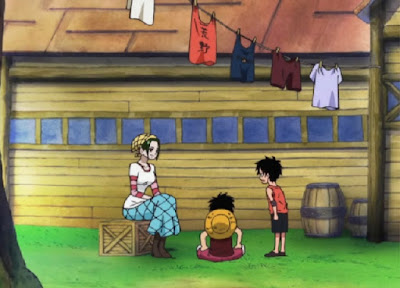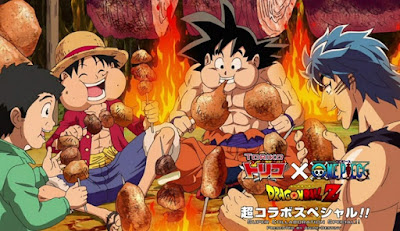This post will be a continuation of the previous post about Family relations.
In my opinion, the most fun to watch in One Piece is when Ace, Sabo, and Luffy were still children, 子供 or こども (kodomo). They are really mischievous, resulting in many funny moments, while there are many touching scenes as well. One of the most memorable scenes is when Ace stole a bottle of alcohol, 酒 or さけ (sake) from Dadan. Ace realized that the three of them may set out to sea separately at different times and they may not be on the same ship or belong to the same crew of pirates. But if the three of them exchange cups of alcohol, regardless of where they are, they are still brothers, 兄弟 or きょうだい (kyoudai).
 |
| Ace learning manners |
As the older brother, 兄 or あに (ani) of Luffy, Ace even tries to learn the proper way to greet people, as he wants to thank Shanks for what he had done for his younger brother, 弟 or おとうと (otouto). 兄貴 or あにき (aniki) is an informal way to address an older brother and it is also used when addressing a person who is considered one’s senior. When addressing one’s own older brother, お兄さん or おにいさん (oniisan) is usually used. It is also shortened to just兄さん (niisan) or 兄ちゃん (niichan). These can also be used to refer and address a young adult male who is not one’s own brother.
For female siblings, an older sister is referred to as 姉 or あね (ane) and a younger sister is 妹 or いもうと (imouto). Sisters in Japanese is 姉妹 or しまい (shimai). When addressing their older sisters, Japanese people usually call them お姉さん or おねえさん (oneesan) and it can be shortened to 姉さん (neesan) or 姉ちゃん (neechan) as well. Similar to older brother, these can also be used when addressing or referring to a young adult female who is not one’s own sister.
To recap:
|
Kanji
|
Hiragana
|
Romaji
|
English
|
|
子供
|
こども
|
Kodomo
|
Children
|
|
酒
|
さけ
|
Sake
|
Alcohol
|
|
兄弟
|
きょうだい
|
Kyoudai
|
Brothers,
Siblings
|
|
兄
|
あに
|
Ani
|
Older brother
|
|
弟
|
おとうと
|
Otouto
|
Younger brother
|
|
お兄さん
|
おにいさん
|
Oniisan
|
Addressing an older
brother or young adult male
|
|
兄貴
|
あにき
|
Aniki
|
Informal way to address
|
|
姉妹
|
しまい
|
Shimai
|
Sisters
|
|
姉
|
あね
|
Ane
|
Older sister
|
|
妹
|
いもうと
|
Imouto
|
Younger sister
|
|
お姉さん
|
おねえさん
|
Oneesan
|
Addressing an older sister or young adult
female
|
|
兄さん (niisan) & 兄ちゃん (niichan)
|
Friendly or
familiar form of address
|
||
|
姉さん (neesan) & 姉ちゃん (neechan)
|
Friendly or
familiar form of address
|
||
Have a great day.



